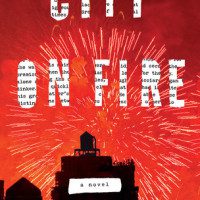Something strange happened with American teenagers in the late 1990s. Ever since the ’50s, when the postwar baby boom conspired with pioneer rock and roll to create the first great American youth culture—when the very idea of a “teenager” first began to mean what it means today—teenagers had been almost definitionally opposed to their parents’ music. Elvis and Chuck Berry and Fats Domino weren’t just different from the big-bands of the 40s or the crooners of the early 50s; they were diametrically different, as if they’d been designed that way. This pattern held from decade to decade and from micro-generation to micro-generation, as teenagers turned away from the past (or even just the music of their older siblings) and embraced the new sound (even if the new sound was simply a juked version of the old sound). But this pattern broke down radically in the ’90s, especially the late ’90s, around the time a young man named Garth Risk Hallberg came of age. What happened, weirdly, was that teenagers started to like their parents’ music.
This seems like important background to City on Fire, Hallberg’s first novel (out this month by Knopf). It centers on a series of events unfolding between New Year’s Eve 1976 and the New York City blackout of July 13-14, 1977. The first long section takes place during New Year’s, and the last long section takes place during the blackout; episodes advancing the story between these two events are interspersed with histories for each of the novel’s nine primary characters. (It’s the same basic structure Jonathan Franzen used in The Corrections, enlarged here to accommodate a more ambitious cast of characters.)
And the characters, God bless them, are people who could only exist in 1977. The pin that holds the book together is a romantic relationship between a closeted gay Great-American-novel-writing black man from Georgia named Mercer Goodman and a skinny white New-York-to-the-bone ur-punk painter named William Hamilton-Sweeney III—which blueblood name and heritage as scion to one of the city’s largest fortunes William has carefully hidden, both from Mercer and the punk scene (where he goes by Billy Three-Sticks). The novel starts with these two, and spreads outward, by links emotional and coincidental, to include William’s troubled sister Regan, her dip-jock husband Keith, Keith’s punk-infatuated, zine-writing mistress Samantha, and Samantha’s angst-riddled running buddy Charlie (who, naturally, nurses a hopeless, john-hughesian crush on her). Mercer happens to teach English at the prep school attended by Regan’s daughter. His ears perk up at the mention of her last-name; at a parent-teacher conference, Regan’s intuition spots Mercer’s interest and she figures out the rest. She gives Mercer an invitation to the Hamilton-Sweeney New Year’s Eve gala, for him to give to William (they’re estranged). William refuses to attend, there’s a dust-up, and Mercer goes in his place. Meanwhile, Samantha and Charlie head into the city from Long Island to catch the New Year’s Eve reunion show of Ex Post Facto, William’s old punk band, which Samantha and her “other friends” obsess over. These other friends form an unruly coven of drug-addled revolutionaries, whom Charlie will fall dangerously in with over the next seven months, after Samantha ditches him at the show to meet up with a mysterious friend who turns out to be Keith, alone on New Year’s and separated from Regan because she knows he’s been unfaithful. After Mercer finds Regan at the party, and the two share a joint on a balcony overlooking the city, Mercer hears a distant pop, and later, on his way home, he finds Samantha’s body, wounded by a gunshot.

The crime brings Mercer into the orbit of a polio-handicapped detective named Pulaski and one of his poker buddies, a freelance journalist named Groskoph, both of whom, in the particular ways of their respective professions, embark on investigations into what happened to Samantha. These procedural inquiries hold the novel nicely together, although to call City on Fire a mystery would be inappropriate for several reasons, not least of which is how the solution to the mystery arrives with no thunderclap or fanfare whatsoever. This is symptomatic of the novel’s long ending, which begins with the blackout, but never exactly climaxes. It sort of fades away, like a heartache. Questions, the answers to which previously drove the story for hundreds of pages, are answered in a way that doesn’t quite deliver, but doesn’t quite disappoint either.
“If the world could write like itself, it would write like Tolstoy,” said Isaac Babel. That’s the kind of ambition Hallberg brought to this book, and forgive me, but there’s a tantric quality to both his prose and the structure here that nicely mimes reality, which sometimes looks as though it wants to tell a story, but never agrees to behave exactly the way stories are supposed to. The writing is strong and loaded and purposeful, but not elegant or pretty or lyrical–though one feels confident this is not because Hallberg isn’t capable of stylistic finery. Rather, Hallberg understands that a novel, especially a long one, can’t afford to strain itself on any one sentence, to reach too far at any given moment. At some point I realized how many of the chapters opened as if the reader had been dropped into a story that had already begun. “The thing is, she never meant to do any of it.” That’s the first line of Chapter 93. “The concept, originally, had been a four-piece. “That’s Chapter 21. There’s a macro/micro structural thing happening there. Hallberg wants to quantum-leap the reader straight into each episode. That’s good writing on the chapter level; but it’s also how all of us are born, how all of us die: to the extent those events are ever momentous, it’s a momentousness we aint privy to. But isn’t that also true of every second in between? Aren’t we always listening for the song and missing the music? Late in the book, Samantha dreams of Patti Smith, and Patti tells her that time is only in her head. Then she clarifies: “A better way of saying this is that time isn’t in your head, exactly—I said that mostly because I wanted it to be true—but that it’s a synonym for life.”
What does this mean? Is it true? Is it too big to be true? Or too big to be false? That’s the ambition of City on Fire. It’s not a big novel about the human condition. It’s a novel that word by word reaches out to capture the smallness of life, the minute particularity that stacks up until—whoa, baby—you’ve got a whole universe on your hands, but a universe that flies away like a pile of dirt in a strong wind.
Like a lot of us who grew up in the late 90s, Garth Hallberg looked into the past and found things back there that surprised him and moved him and changed him, that became what he was into. To cadge a line from Joel Hodgson, we’re obsessed with the past because we know what to say about it. To carry that logic forward and apply it to our generation, something about our own time made us want to imagine ourselves farther back, at moments that seemed more solid—or, at least, more romantically charged. New York City in 1977: How can you know about that and not wish to go back? You think about it, you research it, and you can so easily imagine a Samantha Cicciaro or a Billy Three-Sticks, someone who was there when it was high and best, who was wise enough to sense their own historical good luck, and so enthralled by their own time and place as to feel an impossible urge toward full documentation (Samantha with her ‘zine, Land of a Thousand Dances, William’s with his art project, Evidence).
Reviewing Thomas Pynchon’s Inherent Vice back in 2009 for The Millions, Hallberg wrote, “Pynchon’s great subject has turned out to be not paranoia but history: specifically, those moments in it when the world might change, but doesn’t.” That idea is one of those nuggets of critical genius that is so precise and all-encompassing and dumbstrikingly cool as to override any low skepticism about how such a claim might possibly be proven true or false. It also seems essential to City on Fire; if you read that long, last blackout section carefully, you’ll find it all over the place. Here, almost at the end, a character named Jenny Nguyen responds to another character’s claim that New York, at the time of the blackout, had become “irredeemable”:
“That’s funny, because there was a moment not too long ago when I had this idea the good guys might be returning to take the joint over. A little colony of light…” She caught herself. Though was that still wistfulness in her voice?
How naive and touching that we’d ever expect the world to be as wonderful as it sometimes almost is. It’s math–the real being necessarily infinitely smaller than the ideal. But not just smaller. Duller, too. More compromised, more grown-up. No humdrum nonfiction regime could ever hope to match the exhilaration of a doomed hypothetical, a moment that could never survive, could never endure, that would always be destined for failure and incompleteness by the towering force of its own unsustainable energies. It reminds you of Fear and Loathing in Las Vegas—that line about the high-water mark—and it will remind you, from now on, of the prologue to this massive, friendly, painstaking and gasp-inducing novel. “I mean, who doesn’t still dream of a world other than this one? Who among us—if it means letting go of the insanity, the mystery, the totally useless beauty of the million once-possible New Yorks—is ready even now to give up hope?”





One response
Mr. Jones, I am absolutely sold on Hallberg’s novel. Your piece, this review, is so brilliant, though, I’m also now looking for YOUR novel. Yeah, it’s THAT good. Bravo, Sir.
Click here to subscribe today and leave your comment.